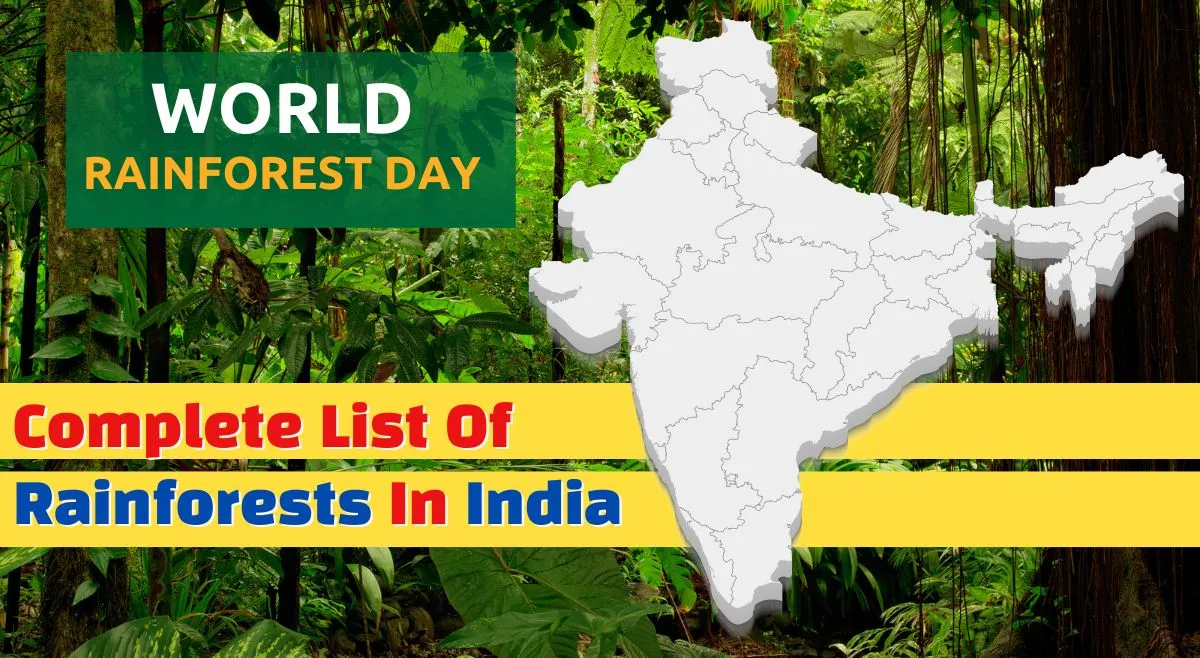- By Ridam Sharma
- Sat, 21 Jun 2025 11:53 PM (IST)
- Source:JND
Indian Rainforests: Every year on June 22, World Rainforest Day is celebrated to spread awareness about the importance and benefits of rainforests across the globe. On the important occasion, let’s take a look at Indian rainforests. India's rainforests are mostly tropical evergreen and semi-evergreen forests. Most of them are located in high-rainfall and high-biodiversity regions. These rainforests are ecologically crucial for India as they are the home to millions of plant and animal species, most of which are endemic or threatened. To know more, here’s a full list of rainforests in India, according to the Testbook and Earth.org data.
Complete List Of Rainforests In India:
| Rainforest/Region | State/Region |
|---|---|
| Andaman & Nicobar Tropical Evergreen Forests | Andaman & Nicobar Islands |
| Western Ghats Tropical Evergreen Forests | Maharashtra, Karnataka, Kerala, Tamil Nadu |
| North Eastern Rainforests | Assam, Arunachal Pradesh, Meghalaya, Nagaland, Manipur, Mizoram, Tripura |
| Brahmaputra Valley Semi-Evergreen Forests | Assam |
| Odisha Semi-Evergreen Forests | Odisha |
| Sundarbans Mangrove & Freshwater Swamp Forests | West Bengal |
| Meghalaya Subtropical Forests | Meghalaya |
| South Western Ghats Moist Deciduous Forests | Kerala, Tamil Nadu |
| North Western Ghats Moist Deciduous Forests | Maharashtra, Karnataka |
| Arunachal Pradesh Tropical Rainforests | Arunachal Pradesh |
Andaman and Nicobar Tropical Evergreen Forests
These islands are covered by some of the best tropical rainforests of India, with more than 86-90 per cent of the land covered with forests. Forests here include wet evergreen, moist deciduous, and mangrove flora, with over 2,200 plant species, of which about 200 are endemic. The forests boast large canopy trees like Andaman Paduak and Andaman Red Cedar, along with medicinal trees like Neem and Indian Mahogany. The stunning karstland forests of Baratang add to the beauty of biodiversity with species adapted to limestone, which are unique and hard to find. These forests have been traditionally dependent on the sustenance and livelihood of the indigenous tribes.
Also Read: World's Largest Snake Species Discovered In Amazon Rainforest: Viral Video Leaves Internet Reacting
Western Ghats Tropical Evergreen Forests
Western Ghats Tropical Evergreen Forests are sparsely populated over Maharashtra, Karnataka, Kerala, and Tamil Nadu. The rainforests of the Western Ghats are a biodiversity hotspot on a global scale. These thick forests possess great endemism, like the rare mammals of the lion-tailed macaque and Nilgiri tahr. The area has distinctive shola-grassland mosaics, along with a diverse range of orchids and medicinal flora. Protected regions of Kudremukh and Nagarhole National Parks preserve this precious diversity.
North Eastern Rainforests
Spanning across Assam, Arunachal Pradesh, Meghalaya, Nagaland, Manipur, Mizoram, and Tripura, these North Eastern rainforests are some of the most serene in India. Lowland and montane tropical forests with high levels of rainfall look beautiful and perfect. Meghalaya also has living root bridges as well as cloud forests, while Arunachal Pradesh's Namdapha National Park is a hotspot of biodiversity with uncommon animal species like the red panda and hoolock gibbons. Orchids, ferns, and varied fauna also live in these forests.
Also Read: Colombia Plane Crash: 4 Children, Including Infant, Found Alive In Amazon Rainforest After 40 Days
Brahmaputra Valley Semi-Evergreen Forests
Brahmaputra Valley Semi-Evergreen Forests are found in Assam. They happen to thrive on alluvial soils and are a combination of evergreen and deciduous forests. They are an important habitat for elephants, primates, and many bird species and contribute significantly to managing floods and ecological balance in the valley.
Odisha Semi-Evergreen Forests
These ancient Odisha forests are a mixture of evergreen and deciduous species. Though less diverse than the Western Ghats or Northeast rainforests, they have significant wildlife like tigers and elephants and rare plant species.
Sundarbans Mangrove and Freshwater Swamp Forests
The Sundarbans is spread across West Bengal and Bangladesh and is the largest mangrove forest in the world. This tidal waterway and mudflat ecosystem is home to the famous Bengal tiger, saltwater crocodiles, and a variety of aquatic species. Mangroves give significant protection from cyclones and coastal erosion.
Meghalaya Subtropical Forests
Meghalaya Subtropical Forests are known for some of the world's wettest locations, like Cherrapunji and Mawsynram. These forests are covered with orchids, ferns, and endemic flora. The area has subtropical cloud forests and the amazing living root bridges, which was built by the Khasi people.
South Western Ghats Moist Deciduous Forests
South Western Ghats Moist Deciduous Forests are found in Kerala and Tamil Nadu. These forests are a transitional area between evergreen and dry deciduous forests. They are known by species that are threatened and by the breathtaking Neelakurinji flower blooms that recur every 12 years.
North Western Ghats Moist Deciduous Forests
These North Western Ghats Moist Deciduous Forests are situated in Maharashtra and Karnataka. These forests are of Gondwana origin and are home to elephants, leopards, and other endemic plant species. They add ecological stability to the Western Ghats region.
Arunachal Pradesh Tropical Rainforests
These immense and relatively uncharted rainforests in Arunachal Pradesh are at the Namdapha National Park, which is India's richest biodiversity zone. The forests are home to red panda and snow leopard, as well as hundreds of birds, for which it is a key area for conservation.
Each one of these rainforest areas in India is ecologically distinct and plays an important role in supporting indigenous populations, regulating the climate, and providing biodiversity.
